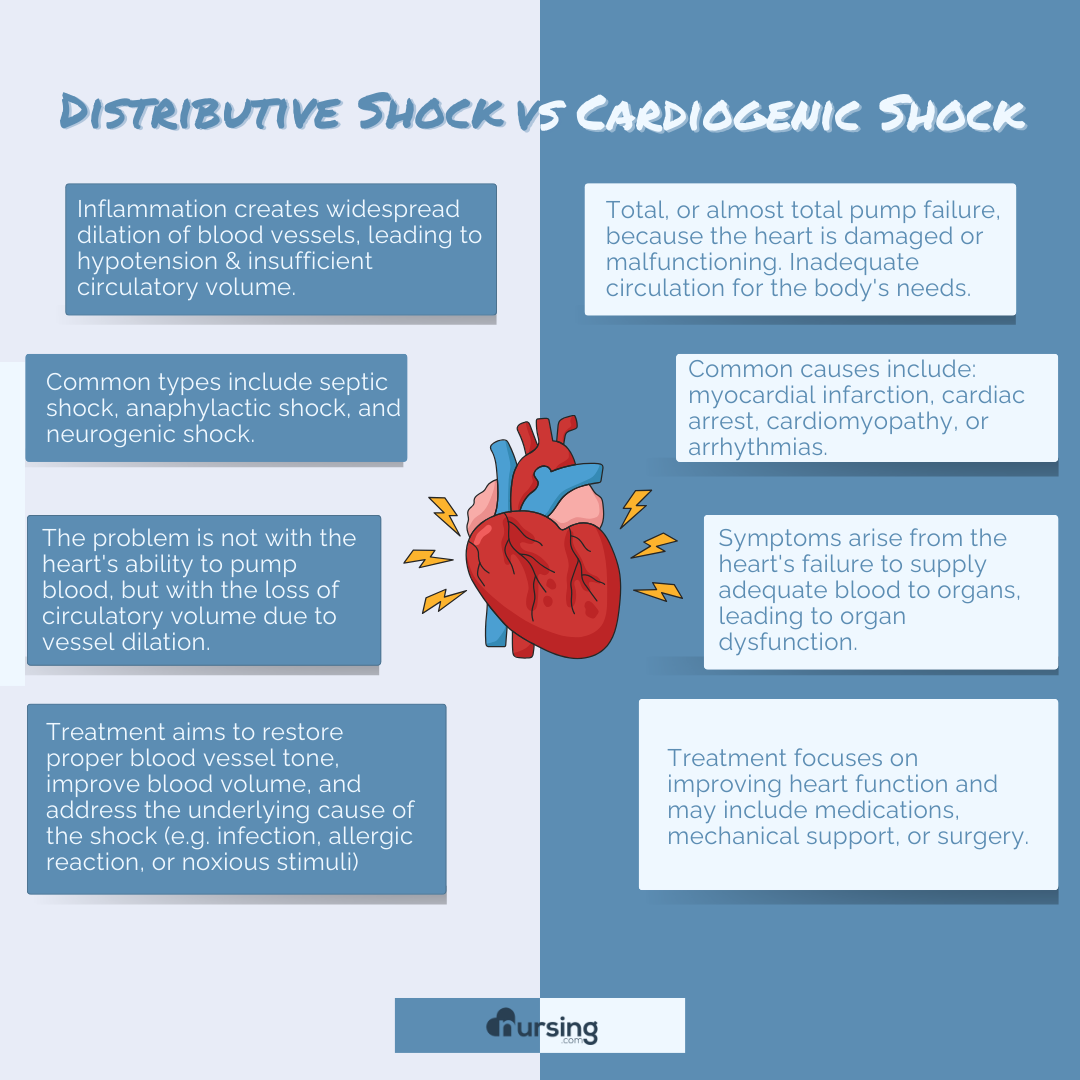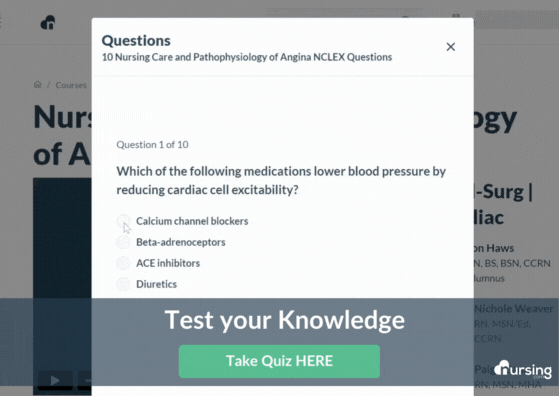What I Wish I Knew: My Patient With Distributive Shock
I had forgotten how much studying I had to do in nursing school.
.png?width=454&height=454&name=Copy%20of%20Copy%20of%20Minimalist%20Planner%20Pages%20Mockup%20Instagram%20Post%20(6).png)
This week I opened up some old nursing school notes, and I started remembering how hard nursing school really was!
I remember, in particular, getting a little confused between the different types of shock. When I was studying distributive shock I found one key 🔑 point that actually cleared up a lot of the misunderstandings and confusion. That started to really turn things around for me in nursing school!
So what worked for me was figuring out that key 🔑 point that helped clarify the different types.
Most people think of 'shock' as emotional distress or sudden fright in response to a traumatic event. But in nursing terms, shock is when you do not have enough blood circulating around your body.
So distributive shock is a type of shock in which blood is not being “distributed” as it should be - hence the name distributive shock.
Meet Nurse Abby
Hi, I’m Abby and today I am a practicing Registered Nurse . . .

. . . but I remember during nursing school I struggled to figure out the difference between distributive shock and other types of shocks, like,
- What is the difference between septic shock and distributive shock
- Or maybe. . . anaphylactic shock and distributive shock
- Or even . . . neurogenic shock and distributive shock
Maybe you caught on quicker than I did, but distributive shock is the bucket that the other three fall in. So septic, anaphylactic, and neurogenic are all types of distributive shock.
All three of them have a common symptom or response that interferes with vascular tone and causes massive peripheral vasodilation, which disrupts “distribution” of blood throughout the body.
⬆️ This is the key 🔑 to knowing that we are dealing with distributive shock.
Now, before we really dig in here, if you click the button below you can take a quiz on distributive shock to check your current level of understanding. Go ahead and take that quiz right now and then I'll tell you a bit more about the different types of distributive shock.
Go ahead, I’ll wait . . . just click here.
How did you do?
Now back to the story…
I mentioned massive peripheral vasodilation is the key 🔑 to knowing that we are dealing with distributive shock, but why is that?
Dig into your knowledge of the Anatomy and Physiology of the circulatory system. ➡️
- Under normal conditions, the blood flows from the heart to the essential and non-essential organs, and tissues and back again through the vessels.
- But if there is a problem with the vascular tone, blood pressure suffers causing the blood to pool in the periphery instead of circulating through the body and back to the heart like normal.

What effect will this have?? If the blood is pooling, instead of circulating, that equals lower blood pressure, and reduces blood perfusion to the tissues and organs.
If there is not enough pressure or blood volume in the vessels, blood and oxygen have trouble reaching the brain. So in this case, you will start to see confusion in the patient.
Reduction of flow also affects the kidneys, and means they will not function properly, so there will be decreased urinary output.
These are a few signs and symptoms of distributive shock, but let's dig a little deeper into the specific types of distributive shock:
- Septic shock
- This will probably be the most common case of shock you will deal with in a hospital. It was for me.
- Septic shock develops from an overwhelming infection. The infection causes an immune response which interferes with vascular tone and we get the problems we were just talking about
- For more details specifically on septic shock we have a Septic Shock Case Study that you can review.
- Anaphylactic shock
- This is similar to septic shock, but instead of an infection causing an immune response, it is an allergic reaction causing the immune response and interferes with vascular tone.
- For more info on just anaphylactic shock, we have a Nursing Care Plan for Anaphylaxis to help you study.
- Neurogenic shock
- This is different from septic or anaphylactic shock, instead of the problem involving the immune system, the problem is caused by a loss or disruption of the sympathetic nervous system.
- This is a result of an injury to the spinal cord. The injury causes a decrease in sympathetic nervous system activity which results once again in interference with the vascular tone.
- Normally, the heart would try to compensate and beat faster when it senses lower blood volume, or hypotension. However an important symptomatic difference between neurogenic shock and the others under the umbrella of distributive shock, is that a patient experiencing neurogenic shock actually experiences bradycardia due to SNS disruption.
- So, remember, when there is interference in vascular tone the blood will start to pool in the peripherals instead of circulating as expected, and could lead to distributive shock.
These are common situations that you will deal with while working as an RN.
I stressed about passing my classes and ultimately passing the NCLEX when i was in nursing school. As mentioned above for a lot of nursing school I was overwhelmed by how much time I had to devote to studying
I found success when I started using NURSING.com because it helped me find the must-know information with clear and concise videos, and then I would check my knowledge with the lesson quizzes.
I used the SIMCLEX to not only evaluate if I was ready for the NCLEX, but it would also give me personalized suggestions on what I should study to fill in my knowledge gaps.
I could focus on those topics further with custom quizzes as well as using the additional study tools that are adapted to my personal learning style.

Distributive Shock Pathophysiology
Identifying Distributive Shock
First, let's quickly look at the difference between our two main types of shock so you can see the differences. Then we will break down distributive shock into it's 3 main types.
| Distributive Shock | Cardiogenic Shock |
| Inflammation creates widespread dilation of blood vessels, leading to hypotension and insufficient circulatory volume. | |

Distributive Shock Signs and Symptoms:
- Anaphylactic
- Hives, rash, swelling of arms, trunk, or face/mouth
- Exposure to allergen
- ↓ SpO2
- ↓ BP
- ↑ HR
- ↑ RR, wheezes
- Warm, flushed skin
- Neurogenic
- Spinal cord injury in last 24 hours
- Warm flushed lower extremities
- ↓ BP
- ↓ HR (occasional)
- Priapism (due to vasodilation)
- Septic
- ↓ LOC
- ↓ BP
- ↑ HR
- Warm, flushed skin
- ↑ Temperature
- s/s infection
Right-Sided Heart Failure:
-
- Cause: Often secondary to left-sided heart failure, chronic lung diseases (such as COPD), or conditions affecting the right ventricle directly.
- Pathophysiology:
- Impaired Right Ventricular Function: Inability of the right ventricle to effectively pump blood into the pulmonary circulation.
- Consequences: Backflow of blood into the systemic venous circulation, leading to systemic congestion, peripheral edema, and hepatomegaly.
.png?width=533&height=533&name=Nursing%20Mnemonic%20for%20right%20side%20heart%20failure%20(3).png)
Heart Failure Signs and Symptoms:
- Shortness of Breath (Dyspnea):
- Patients may experience difficulty breathing during activity or while resting, particularly when lying flat (orthopnea). They might need to prop themselves up with extra pillows to breathe easier.
- Fatigue and Weakness:
- Feeling unusually tired or weak during everyday activities due to insufficient blood flow and oxygen to muscles.
- Swelling (Edema):
- Fluid buildup can cause swelling in the legs, ankles, feet, or abdomen, leading to weight gain and bloating.
Diagnostic Tests for Heart Failure:
- Echocardiogram (Echo):
- Think of this as a special camera that uses sound waves to take pictures of your heart in action. It shows doctors how your heart moves and pumps blood. They can look at the size and shape of the heart and its parts, like the chambers and valves. It also helps them figure out the ejection fraction, which is a number that tells them how well your heart pumps with each beat.
- Electrocardiogram (EKG or ECG):
- This test checks the heart's electrical activity to see how it's beating. Sticky pads called electrodes are placed on your skin, and they pick up the electrical signals that make your heart beat. This test can show if the heart's rhythm is normal or irregular, if the heart is too big, and if there's been any heart attack or damage to the heart in the past.
- Blood tests:
- Natriuretic peptides (BNP or NT-proBNP): These are special proteins that the heart releases when it's working too hard. If someone has a lot of these proteins in their blood, it might mean they have heart failure.
- Doctors also use other blood tests to check on different things that might affect the heart or be affected by heart failure, like the kidneys, liver, thyroid, the number of blood cells, and fats in the blood.
I stressed about passing my class and ultimately passing the NCLEX.
I found success when I started using NURSING.com because it helped me find the must-know information with clear and concise videos, and then I would check my knowledge with the lesson quizzes.
The huge difference in symptoms between right- and left-sided heart failure became clear, and I could picture what was going on!
I used the SIMCLEX to not only evaluate if I was ready for the NCLEX, but it would also give me personalized suggestions on what I should study to fill in my knowledge gaps.
I could focus on those topics further with custom quizzes as well as using the additional study tools that are adapted to my personal learning style.

If you are still looking for those moments where everything clicks and you start to think like a nurse. . . what worked for me what NURSING.com - and for more specifically on the heart you can go to nursing.com/heart.
Now, to help build your heart failure knowledge and start piecing together the beginnings of a heart failure care plan.
Distributive Shock Care Plan
Distributive shock is a common condition you will deal with working as an RN. Let me share part of my care plan with you, that I would use to help a patient with distributive shock
Let’s start with the desired outcomes for the patient
Desired Outcomes for Distributive Shock Nursing Care:
- Restoration of adequate tissue perfusion and oxygenation.
- Stabilization of hemodynamic parameters (blood pressure, heart rate, urine output).
- Identification and treatment of the underlying cause of shock.
- Prevention of complications such as organ failure.
Subjective Data:
- Patient reports of symptoms related to the underlying cause (e.g., infection, allergic reaction).
- Anxiety or distress due to the acute condition.
Objective Data:
- Signs of hypotension and tachycardia.
- History of recent events or conditions (e.g., trauma, spinal injury, exposure to allergens).
- Altered mental status or decreased level of consciousness.
- Laboratory findings indicating the underlying cause (e.g., infection markers, allergen-specific IgE).
- Hemodynamic monitoring data (e.g., central venous pressure, cardiac output).
Nursing Assessment for Distributive Shock:
- Continuous monitoring of vital signs and hemodynamic status.
- Assess for signs and symptoms of the underlying cause.
- Evaluate response to treatment interventions (fluid resuscitation, vasopressors).
- Monitor for complications like acute renal failure or respiratory distress.
Nursing Interventions and Rationales for Heart Failure
Evaluation for Distributive Shock Nursing Care:
.png?width=2240&height=800&name=Copy%20of%20Header%20Banner%20for%20Blog%20(2).png)
The entire Distributive Shock Care Plan, along with 230+ other care plans, are available on NURSING.com.
Looking for more? Visit NURSING.com/heart now to download a Nursing cheat sheet for free.
I hope this has helped you understand heart failure a bit better so you know what to look out for.
We’re rooting for you . . . Go out and be your best self today. . .
Happy Nursing!





.png?width=589&height=589&name=Minimalist%20Planner%20Pages%20Mockup%20Instagram%20Post%20(2).png)


